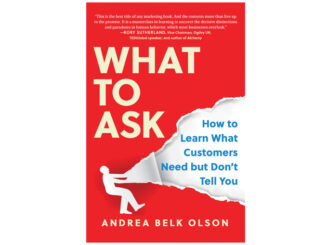by Tom Rich, Thomas M. Rich & Associates, Westfield, New Jersey, tomr@thomasmrich.com, @RichThomas
Qualitative researchers spend quite a lot of time trying to figure out why people think what they think and do what they do. There are many models and schools of thought on motivation, but one that gets little attention from researchers and marketers is morality—our intuitive sense of right and wrong.
Case in point: a few years ago, I was conducting research on medication noncompliance. We interviewed people with a variety of chronic conditions, including obesity, hypertension, dyslipidemia, asthma, multiple types of diabetes, and various autoimmune conditions. They had all struggled with these conditions for years, some for decades, and had been steadily losing ground. Yet, their compliance rate for taking their medications was very low. (By the way, in case you’re wondering, this was a very easy study to recruit—we had no difficulty finding individuals who met these specifications.)
When the conversation got around to why they were so unlikely to take their medications, or to even fill their prescriptions, most participants started out by talking about cost and side effects. However, it only took a little bit of additional conversation for them to acknowledge that these justifications were just red herrings, not the real reason. The participants then explained their behavior by saying something like “it’s just too easy,” or “that’s not the right way to do it.” Ultimately, they felt that medicating these conditions was somehow wrong. In other words, it was immoral. This perceived immorality was the primary barrier to compliance. This attitude carried over to other ways of addressing these conditions. For instance, when the topic of bariatric surgery came up in one interview, the participant described that approach as being “borderline sinful.”
What Is Morality?
There’s no shortage of definitions for the term, and certainly no single correct one, but here are a few explanations of morality to establish a context for you:
- That morality is our innate, intuitive sense of right and wrong is a highly practical definition. People tend to make moral value judgments quickly and instinctively, much the same way we make aesthetic judgments. We might not always be able to explain precisely what moral or immoral behavior is, but we know it when we see it.
- Morality can be thought of as a cognitive system—inputs go in, perceptions and actions come out. B.F. Skinner, one of the most influential psychologists of the twentieth century, would probably say morality is one of those mysterious, unobservable things inside that black box he wrote about.
- Social psychologists have described morality as a means of balancing the needs of the individual with the needs of the group. The fact that humans can act cooperatively and altruistically has enabled us to organize ourselves into groups (tribes). This organizational structure is fully dependent on an ability to think in moral terms. Nowadays, we no longer live in tribes. Instead, we create our tribes through such mechanisms as our interests, political affiliations, ethnicity, and so forth, and we highly value loyalty to them.
- Morality is an evolved trait, directly linked to our species’ extremely large brain. Our exceptional cognitive ability allows us to think deeply about our actions, and our ability to control our own behavior makes us responsible for their consequences. Therefore, our ability to exercise free will is intrinsic to morality. Morality is one of the things that defines us as humans. It is at the core of all our societal norms. It is at the root of all religious traditions. In fact, you could make the argument that establishing and defining morality is the primary purpose of religion.
- Ultimately, morality is a mindset—a lens through which we see our world. It influences our view of everything we encounter. I’ve spent a lot of time studying mindset models, and they’re among the most valuable tools I use as a researcher. Difficult-to-understand or seemingly irrational behavior in others becomes clear when we view it through the operative mindset. Morality, however, is the mother of all mindsets. It’s constantly active, constantly influencing our perceptions, and constantly informing our decision-making. So, it’s essential that researchers always be aware of it.
It’s important to remember that morality is inextricably linked to the idea of free will. Philosophers have been telling us for centuries that the factor that distinguishes us from other animals is that we are not slaves to our fundamental nature. We can elevate ourselves above our basic desires and fears and choose what we will be and what we will do. So, when we judge the behavior of others, we are making the fundamental assumption that their choices are conscious and voluntary.
Moral Foundations Theory
Jonathan Haidt is a social scientist and moral psychologist. He wrote a book in 2012 called The Righteous Mind. It’s based on many years of studying moral perceptions and behavior, using systematically collected and rigorously analyzed data. This is probably the most important work on morality anybody has undertaken in the past century, and I can’t recommend this book highly enough.
Haidt’s fundamental premise is that, while we would like to think that we reason our way into what we believe about right and wrong, we believe our way into our reasons. In other words, we create post hoc rationalizations for what we think and do. We all have innate moral intuitions, and those intuitions are at the root of our beliefs, perceptions, and actions, not rational analysis. Haidt is known for saying that “morality binds and blinds.” It’s crucial to social cohesion, but it also makes it very difficult to understand people outside of our way of thinking.
Haidt’s research revealed six innate, fundamental, cross-cultural underpinnings of our sense of morality. Following are some very brief descriptions of them. If you want more detailed descriptions, you’ll need to read the book.
- Care/harm—this foundation comes from our innate desire to care for and nurture others and underlies such virtues as kindness and gentleness.
- Fairness/injustice—this is related to the evolutionary process of reciprocal altruism. It underlies ideas of justice, inalienable rights, and balance. We have an innate sense that things should be “fair,” and that one good turn deserves another.
- Loyalty/betrayal—as I’ve pointed out, we’re tribal animals. We highly value loyalty. This foundation underlies such virtues as patriotism, identification with a specific ideology, and self-sacrifice for the group.
- Authority/subversion—submission to authority is a powerful driver in family, religious, military, and corporate contexts. Unlike most other animals, authority among humans is less based on physical dominance, and more on voluntary deference.
- Purity/degradation—this is related to the ideal that we can attain virtue by controlling what we do with and put into our bodies or minds. It underlies religious notions of striving to live in an elevated, less carnal, more noble way, and drives the widespread idea that the body is a temple which can be desecrated by immoral activities and contaminants.
- Liberty/oppression—this is about the feelings of resentment people feel toward those who dominate and restrict liberty. The American Declaration of Independence and Constitution are both very much about this moral foundation.
Haidt’s purpose in creating this framework was to help us understand ourselves, and maybe be a little more rational. He’s quite concerned with political and social dysfunction and would like to play a role in helping foster private and public discourse that can help us communicate and understand each other better. That’s all very noble, but for researchers and marketers, it has somewhat different applications. This model of morality is highly useful for creating a schematic for consumer perceptions and decision-making. It could be argued that Haidt’s model might be the only one you really need—it’s kind of a unified field theory of morality.
Sin and Virtue
A hugely important moral framework—one we encounter all the time—is the Christian worldview of sin and virtue.
Many of us were brought up with this model of morality, especially those of us who went to Catholic school. The very idea of sin is a uniquely human one; once it’s programmed into you, it never goes away. It’s an entirely binary way of looking at things—something is either one thing or it’s another, either a vice or a virtue. There are no gray areas.
| The seven deadly sins from Roman Catholic theology | The seven corresponding virtues |
| Gluttony | Prudence |
| Sloth | Justice |
| Lust | Temperance |
| Pride | Courage |
| Wrath | Faith |
| Envy | Hope |
| Greed | Charity |
Morality and Marketing
Morality is intrinsic to nearly all marketing issues and is an important component in branding. Brand personality and brand equity usually have a moral element, and brands and their competitors are often associated with specific virtues and sins.
Consider two brands from Seattle that have often come up in my research studies: Starbucks is often associated with fairness and good corporate citizenship, while Amazon tends to be associated with rapaciousness.
Morality is also key to segmentation—different consumer segments are often motivated by different moral imperatives. Morality is particularly important when it comes to politics. Nearly all political branding and brand communication is built around moral considerations.
For us to understand the role moral considerations play in consumer perceptions and decision-making, we need tools—some systematic ways to think about morality and to design and analyze research with morality in mind.
Putting Morality to Work
Here are some practical tips on how to explore the topic of morality within a qualitative research context.
- Get yourself into the habit of looking for morality. This is probably the most important principle of all. Simply becoming attuned to morality is probably 80 percent of the job. Do that and everything else will pretty much fall into place. Morality is already being talked about in your research—you just need to learn to recognize it.
- Make sure you have pre-loaded thinking about morality you can draw upon. In other words, become well versed in at least a few moral models.
- Think ahead about the various moral considerations and mindsets you might encounter during your research. Then prepare some questions and exercises to explore them, and include them in your discussion guide. Be sure to stay flexible in your thinking, as your initial expectations might turn out to be completely incorrect. However, as Dwight Eisenhower used to say, “Plans are useless, but planning is essential.”
- Create a reference sheet on moral models and vocabulary cues for yourself. When I first started teaching myself to explore morality as a researcher, I found this to be invaluable.
- Realize that you also have moral lenses through which you view the world, and make sure you know what they are for the research topic. By calling out and fully understanding your own biases, you can prevent them from overly influencing your own thinking or how you ask questions.
- Don’t judge. Some behaviors are driven by morality, but some really aren’t. We tend to ascribe the dysfunctional and maladaptive behaviors of others to character flaws and degeneracy, rather than to things like mood disorders, unresolved trauma, neurochemical imbalances, and other factors that cause them, and then we judge harshly. Everybody does this—it’s a very human thing to do. But, if you’re a researcher, it’s a luxury you can’t afford. Moralizing is conversational poison. It walls you off from empathy and prevents clear-eyed analysis of your data.
Morality is the classic “elephant in the room”—always there, enormous, and rarely discussed. A researcher who is well versed in how moral considerations influence consumer perceptions and behavior can be an invaluable resource to end-clients. So, go ahead—make yourself an expert. Read Jonathan Haidt’s book, study other moral frameworks, and train yourself to watch out for morality issues. In doing so, you’ll be taking an important step in raising your own professional qualifications.

Coded Language for Moral Issues
Research participants talk about, or indirectly refer to, moral considerations frequently. Sometimes they do so overtly, but more often it comes in coded language. If respondents are having difficulty articulating why they feel as they do about something, or if they’re being vague, evasive, or dishonest, morality might be lurking beneath the surface. Here are some words, phrases, and ideas that I hear frequently from research participants that might signal they’re talking about moral issues:
- Choice—remember, morality is closely tied to the idea of free will. When people are describing an action as a choice, they may be referencing this concept.
- Self-sacrifice or the greater good—because morality is a mechanism for balancing the needs of the individual with the needs of the group, this often requires virtuous, altruistic behavior.
- Self-reliance – this is part of what I call “the morality of freedom,” a particularly American construct. When you hear people talking about attending to one’s own responsibilities, or invoking the term “bootstraps,” they’re probably referring to the virtue of not depending on others.
- Things being too easy—many models of morality, particularly religious ones, place great value on hard work, suffering, and self-denial.
- Fairness—social psychologist Jonathan Haidt has identified several foundations of morality; fairness, equality, and reciprocity make up one of them.
- Purity or sacredness—this another of Haidt’s foundations. Cleanliness and sanctity are important moral virtues.
- Respect for authority—yet another one from Haidt. Groups are unlikely to function efficiently without hierarchy, so it makes sense that respect for authority should be seen as virtuous.
- Consistency—the ability to “stand firm” in the face of change is often associated with strength of character.




